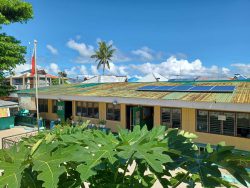
The port of Talibon in Bohol is a hive of activity in the mornings. Small pump boats cut through the bay and dock near the rocky beach. The passengers—spare, sunbaked—disembark and wade through the knee-deep water towards the market, the men laden with cargo, the women with children. A stone’s throw from the market, the jetty juts out into the water, lined by towering white solar-powered streetlamps. Pump boats cling to either side and disgorge commuters from the islands scattered off the northern coast of Bohol Island, on the Camotes Sea.
At nine o’clock every morning, a larger boat, newer looking than the rest, noses its way to port. Easily accommodating 30 people, the boat named Super Jereco began plying the Nocnocan-Talibon route after Typhoon Rai, better known to locals as Typhoon Odette, hit the Philippines in December 2021. The Category 5 typhoon destroyed many of the small fishing boats that doubled as inter-island transport for the locals, and Super Jereco filled the gap. Passengers pay 50 pesos per head to be ferried over a dozen or so kilometers in each direction.
On the side of the boat, in lettering that recalls a government tourism campaign, is the proud declaration: ‘I love Nocnocan.’ It could be one of those slogans emblazoned on tourist memorabilia the world over. ‘I love Paris’ or ‘I love NY,’ or maybe, closer to home, ‘I love Boracay.’ But Nocnocan is no tourist haunt. It is not a resort island where holidaymakers could flee the hubbub and noise of the city and other people. In fact, Nocnocan, a tiny island among the 7,000-plus islands that make up the Philippine archipelago, is said to be among the most densely populated pockets of the country. Here, around 2,000 people share less than 4 hectares of space.
To put this in perspective, four hectares is the floor area of SM Mall of Asia, the Philippines’ biggest mall. Four hectares. That is the current estimate of Nocnocan Island’s land area. What sea level rise would do to that figure remains to be seen, but projections are dire: A Climate Central map of sea level forecasts for 2050 shows more than two-thirds of the island underwater. Mall of Asia has three stories. If predictions prove accurate, this island barangay will effectively be reduced to the equivalent of a single story of a giant shopping mall.
Off-grid living, without the romance
This mall-size island is one of the sites of the Research and Advocacy for Climate Policy and Action (RACPA) project run by JRSAP with the support of the Australian Government through Caritas Australia under the Australian NGO Cooperation Program (ANCP).
During a visit in November 2023 by JRSAP and its implementing partner in the Philippines, Environmental Science for Social Change (ESSC), 2050 seemed far from the minds of the residents of the island. The question of what the island would be like in the middle of this century takes a back seat to the day-to-day struggle for subsistence and the challenges of living on what is little more than a sandbar many miles from the mainland.
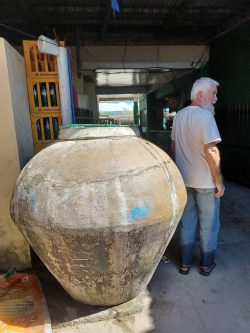
Water is a perennial problem, an irony for a community surrounded by a vast expanse of it. Their drinking water used to come from rainfall collected in hulking jars, but this has long since been replaced by purified water from refilling stations in the mainland. Every day, pump boats laden with empty 20-liter plastic water containers can be seen leaving the island and returning with their precious cargo, to be sold to the residents at 50 pesos per container, double what they would have cost in Talibon.
Rainwater, when the rains come, meets the households’ other water needs. Old jars and large blue plastic barrels stand outside houses to collect runoff from the roofs, but the community now mainly relies on large tanks constructed and refurbished over the years through a series of government-funded projects. Fading billboards announcing the details of these public improvement works surround the covered court in front of the Nocnocan Multipurpose Building, where the main tanks are located.
Young men or boys could often be found engaged in spirited game of basketball in the court, but on a recent afternoon, there are only two people, a middle-aged man and a young girl collecting water from a pipe a few meters away from one of the basketball hoops. The low water level in the tank is unable to produce enough pressure to push the water through the pipe even though it is built close to the ground, so the residents have cut a hole in the ground and placed a basin there to catch the water, which is then scooped with a dipper into their containers.
The residents pay 20 pesos for three five-gallon jugs of water that can be used for cooking and cleaning. When the water stored underground runs out, as it often does, the residents have no choice but to buy water from the mainland at 30 pesos for five gallons. Lack of rain is not the sole culprit for the unsteady water supply; the tanks have been leaking and need to be repaired, again. Meanwhile, another large tank beneath the stage in the smaller basketball court near the elementary school sits unused, damaged by Typhoon Odette.
The water scarcity on the island has significant implications for the residents’ health. Rebecca, a barangay health worker, says cases of diarrhea are frequent among the children. Highly sugared soda is popular, and on a recent afternoon, there was a boat docked nearby, collecting more than a hundred crates of empty bottles.
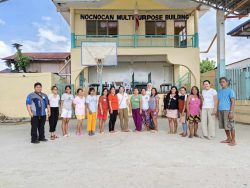
Climate change is likely to exacerbate these problems. As people’s water needs increase along with the heat, the same heat will lead to faster water evaporation even as irregular rainfall makes it harder to replenish the water stored in the tanks, jars, and barrels. Meanwhile, sea-level rise puts the stored rain water at greater risk of contamination by saltwater.
Electricity is another problem for the community. Following Odette, the National Power Corporation made photovoltaic solar home systems available. At a monthly fee of 220 pesos, each household can use two light sources and a charging station for electrical devices. Except for the few who could afford more expensive solar systems or diesel-powered generators, the limited power supply renders the use of washing machines, refrigerators, and electric fans, much less air-conditioning, out of the question.
To live in Nocnocan Island is to live off-grid, with none of the romantic connotations some people attach to the experience. How well the solar panels would hold up against another supertyphoon is a question everyone hopes would not be tested, but what happened during Typhoon Odette, when many of the houses on the island lost their roofs, does not inspire confidence.
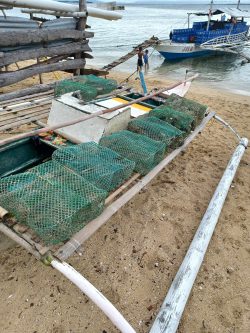
The lure of livelihood
Almost two years have passed but signs of the damage wrought on the island by the supertyphoon remain visible. Several houses still stand in ruins. Not only did many houses lose their roofs, the flimsiest of them, with walls made of plywood and woven bamboo, were destroyed entirely. Most have been rebuilt, some with assistance from the church, which provided building materials, or from NGOs, which provided the labor of volunteers. But the houses in the areas deemed most risk-prone did not receive such assistance, to discourage them from rebuilding in these danger zones. Without the benefit of support, some rebuilt anyway, cobbling together haphazard shelters from bamboo, rusting tin sheets, and tarpaulin.
A number of these shelters stand on the northern side of the island, hidden from view from boats coming in from the mainland. Due to the movement of sea currents, this is where debris is deposited, and large volumes of marine litter were dumped here by Typhoon Odette. Lacking solid waste management facilities, the residents, too, have made the area a sort of landfill. The makeshift shelters rise on stilts above this patchwork of garbage. In one area, coral rock had been gathered into a tall pyramid resembling a cairn. You wonder what or whose memory is being honored until you see the tangle of plastic trash on top.

The residents of Nocnocan Island probably produce less waste than the average Filipino and far less than the average resident of the Global North, but the island’s small size and location make it harder for the community to externalize what waste they produce, as most communities tend to do. There is no question of sequestering their trash in distant landfills because transporting them back to the mainland is a costly operation.
The garbage mars one of the features that make Nocnocan Island special: the coral reef on which the island rests, which belongs to Danajon Bank, said to be one of only six double barrier reefs in the world. This geological formation makes the area a rich fishing ground and explains why the residents insist on staying in spite of the island’s many problems. Fishing is the community’s main source of livelihood and such good fishing is difficult to find elsewhere. The residents estimate that the island’s fishermen bring in from 600 kilos to a ton of catch per day.
How long this bounty can be sustained is uncertain. It is too early to tell how climate change will impact Danajon Bank, but coral bleaching that comes with warmer seas have been observed elsewhere by marine scientists, for instance, in Australia’s Great Barrier Reef. Even now, in Danajon Bank, fish stock already seems to be declining, though this is likely due to overfishing. Some of the fishermen have had to resort to compressor fishing, a highly risky enterprise, because of the declining catch with pamukot (purse seine) or panggal (fish traps) fishing. Men from the island have died from the practice, but it is a gamble they take for their families. For these fishermen, many of whom had limited formal schooling, fishing is the only skill they know to make a living, the sea the sole workplace they could imagine.

Mapping mobility, immobility
It is a different kind of fish that keeps Nong Pedro and Nay Josie in Nocnocan, even though their grown children, living and working in Cebu, Manila, and Canada, have encouraged them to leave.
When Typhoon Odette wrecked their house and pump boat, Nong Pedro, a carpenter, had to rebuild them. But the couple had lost far more to extreme weather and to the sea: In 2013, the eldest and fourth of their eight children, 31 and 27, were swept away by a storm surge brought by Typhoon Haiyan, locally known as Typhoon Yolanda, while working at a resort in Guian, Eastern Samar. The eldest survived with an injury to his head. The younger died, his body never recovered.
Still, the couple do not plan to leave Nocnocan. Nong Pedro takes pride in his job looking after
the local chapel, and Nay Josie supports him. The chapel was where many residents took shelter during Typhoon Odette. A priest visits the island only one Sunday in each month, and on the other Sundays, it is up to Nong Pedro to organize a liturgy for the island’s Catholic believers. It seems fitting that though not a fisherman himself, he is named after one, St. Peter, whom Jesus called to be a fisher of men.
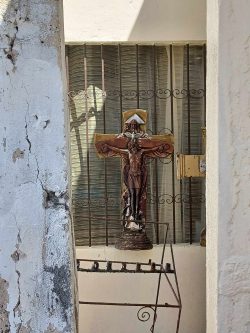
Among the island’s residents, the women, especially those with younger children, seem more ready to contemplate life elsewhere. On a recent afternoon, a dozen of them are gathered in the chapel, field testing a survey with personnel from an NGO, Environmental Science for Social Change (ESSC), as part of a participatory action research on climate change and displacement.
The women say no when they are asked if they are thinking of leaving the island. Asked if they would evacuate if another supertyphoon approaches, they shake their heads. What if it brings a storm surge? “Patay,” they answer, meaning either “Tough luck” or “We’re dead.” They say it stoically, then break into laughter. But when the question is rephrased—would they leave the island if they had the means to do so?—something shifts. The answer is a resounding yes.
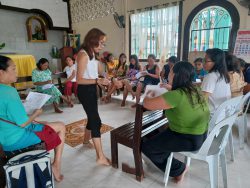
The day before, ESSC had guided three dozen island residents in a community mapping exercise. Giving them markers and Manila paper, they divided them into two groups based on their purok, and asked them to draw the island after Odette. The map drawn by the group made up mostly of women was noticeably more detailed. It showed which houses lost their roof and how high the water was in each place: knee-high here, hip-high in another. These are the women now saying they would leave, if only they had the resources.

These women and their families, Nay Josie and Nong Pedro: They are the human face of loss and damage due to climate change. Access to a loss and damage fund could benefit them by giving them more options—real options—to relocate, or if not, to better adapt in place.
The port of Talibon in Bohol is a hive of activity in the mornings. At nine o’clock, the Super Jereco noses its way to the jetty and lets off its passengers. Splashed on its side are the words ’I love Nocnocan.’ As the morning wears on, the boat once again fills up with commuters. The same men and women who had come in the morning are returning to Nocnocan, errands completed.
Around noon, somebody loosens the mooring rope and lifts the gangplank, and the boat slowly pulls away from the jetty. It cuts through the water to ferry home its passengers, with their bags of rice and jugs of water, with their mental maps and the muted question, whether to stay or to move elsewhere—and how in the world.
